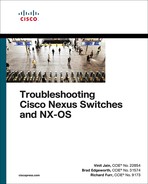Contents
Part I Introduction to Troubleshooting Nexus Switches
Chapter 1 Introduction to Nexus Operating System (NX-OS)
Messages and Transactional Services
Understanding NX-OS Software Releases and Packaging
NX-OS High-Availability Infrastructure
Virtual Routing and Forwarding
Management and Operations Capabilities
Debug Options: Log File and Filters
Configuration Checkpoint and Rollback
Feature Scheduler, EEM, and Python
Chapter 2 NX-OS Troubleshooting Tools
Packet Capture: Network Sniffer
Define and Apply the Flow Monitor
Chapter 3 Troubleshooting Nexus Platform Issues
Troubleshooting Hardware Issues
Generic Online Diagnostic Tests
Out-of-Band and In-Band Management
Troubleshooting NX-OS System Components
Message and Transaction Services
Unicast Routing Information Base
Part II Troubleshooting Layer 2 Forwarding
Network Layer 2 Communication Overview
Using a Promiscuous PVLAN Port on Switched Virtual Interface
Trunking PVLANs Between Switches
Spanning Tree Protocol Fundamentals
IEEE 802.1D Spanning Tree Protocol
Verification of VLANS on Trunk Links
Multiple Spanning-Tree Protocol (MST)
Detecting and Remediating Forwarding Loops
Problems with Unidirectional Links
Spanning Tree Protocol Loop Guard
Chapter 5 Port-Channels, Virtual Port-Channels, and FabricPath
Basic Port-Channel Configuration
Advanced LACP Configuration Options
Minimum Number of Port-Channel Member Interfaces
Maximum Number of Port-Channel Member Interfaces
Port-Channel Member Interface Consistency
Troubleshooting LACP Interface Establishment
Troubleshooting Traffic Load-Balancing
Verifying the vPC Domain Status
FabricPath Terminologies and Components
FabricPath Verification and Troubleshooting
vPC+ Verification and Troubleshooting
Part III Troubleshooting Layer 3 Routing
Chapter 6 Troubleshooting IP and IPv6 Services
Object Tracking for the Interface
Object Tracking for Route State
Object Tracking for Track-List State
Using Track Objects with Static Routes
Chapter 7 Troubleshooting Enhanced Interior Gateway Routing Protocol (EIGRP)
Troubleshooting EIGRP Neighbor Adjacency
Verification of Active Interfaces
Connectivity Must Exist Using the Primary Subnet
Problems with Hello and Hold Timers
Interface-Based EIGRP Authentication
Troubleshooting Path Selection and Missing Routes
Classic Metrics vs. Wide Metrics
Chapter 8 Troubleshooting Open Shortest Path First (OSPF)
Troubleshooting OSPF Neighbor Adjacency
Confirmation of OSPF Interfaces
Connectivity Must Exist Using the Primary Subnet
Interface Area Numbers Must Match
OSPF Stub (Area Flags) Settings Must Match
Troubleshooting Missing Routes
Troubleshooting OSPF Path Selection
Problems with Intermixed RFC 1583 and RFC 2328 Devices
Chapter 9 Troubleshooting Intermediate System-Intermediate System (IS-IS)
Designated Intermediate System
Troubleshooting IS-IS Neighbor Adjacency
Confirmation of IS-IS Interfaces
Connectivity Must Exist Using the Primary Subnet
Area Must Match Between L1 Adjacencies
Checking IS-IS Adjacency Capabilities
Troubleshooting Missing Routes
Chapter 10 Troubleshooting Nexus Route-Maps
ACLs and ACL Manager Component
Interior Gateway Protocol (IGP) Network Selection
Prefix Matching and Prefix-Lists
Multiple Conditional Match Conditions
Incomplete Configuration of Routing Policies
Diagnosing Route Policy Manger
Chapter 11 Troubleshooting BGP
BGP Configuration and Verification
Troubleshooting BGP Peering Issues
Troubleshooting BGP Peering Down Issues
Verifying Reachability and Packet Loss
Verifying ACLs and Firewalls in the Path
Demystifying BGP Notifications
BGP Route Processing and Route Propagation
Soft Reconfiguration Inbound Versus Route Refresh
Scaling BGP with Route-Reflectors
Loop Prevention in Route Reflectors
BGP Route Filtering and Route Policies
Looking Glass and Route Servers
Part IV Troubleshooting High Availability
Bidirectional Forwarding Detection
Asynchronous Mode with Echo Function
Configuring and Verifying BFD Sessions
Graceful Insertion and Removal
Part V Multicast Network Traffic
Chapter 13 Troubleshooting Multicast
Protecting the Central Processing Unit
NX-OS Multicast Implementation
Multicast Boundary and Filtering
Event-Histories and Show Techs
PIM Candidate RP Advertisement Message
PIM Interface and Neighbor Verification
PIM ASM Event-History and MROUTE State Verification
Auto-RP Configuration and Verification
BSR Configuration and Verification
Anycast-RP Configuration and Verification
Multicast and Virtual Port-Channel
vPC Considerations for Multicast Traffic
Part VI Troubleshooting Nexus Tunneling
Chapter 14 Troubleshooting Overlay Transport Virtualization (OTV)
Flood Control and Broadcast Optimization
Understanding and Verifying the OTV Control Plane
OTV IS-IS Adjacency Verification
OTV Control Plane Policing (CoPP)
Understanding and Verifying the OTV Data Plane
OTV ARP Resolution and ARP-ND-Cache
OTV Unicast Traffic with a Multicast Enabled Transport
OTV Multicast Traffic with a Multicast Enabled Transport
OTV Multicast Traffic with a Unicast Transport (Adjacency Server Mode)
First Hop Routing Protocol Localization
Part VII Network Programmability
Chapter 15 Programmability and Automation
Introduction to Automation and Programmability
